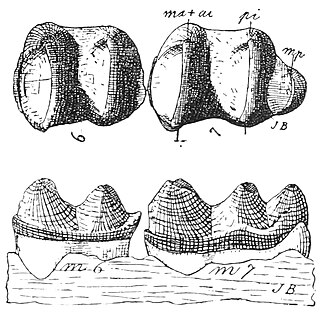Description
This animal is only known from its fossilized dentition. From a comparison with its close relatives, it is supposed that it was a large herbivorous mammal, vaguely similar to an elephant and with massive limb ; it was decidedly smaller than Pyrotherium but still of considerable size, and it is supposed that it was at least two meters long. It was endowed with incisors developed in elongated and forward pointed tusks, with a limited growth, and had large bilophodont molars.
The study of the dentition of Propyrotherium indicates that it had two premolars and three molars in both the maxilla and the mandible. THe teeth gradually increased in size towards the back of the jaws, and the upper teeth gradually increased in the curvature of the ridges, as in Pyrotherium. Although they were bilophodont, the premolars possessed shorter anterior lophids than posterior ones, From the third upper premolar to the third upper molar the teeth were square-shaped and had three toots, while those from the third lower premolar to the third lower molar were longer than their width, with two roots and a vestigial oblique cristid. In many characteristics of its dentition, Propyrotherium differed from Griphodon and Baguatherium .

Pyrotheria is an order of extinct meridiungulate mammals. These elephant-like ungulates include the genera Baguatherium, Carolozittelia, Colombitherium, Griphodon, Propyrotherium, Proticia, and Pyrotherium.

Pyrotherium is an extinct genus of South American ungulate, of the order Pyrotheria, that lived in what is now Argentina and Bolivia, during the Late Oligocene. It was named Pyrotherium because the first specimens were excavated from an ancient volcanic ash deposit. Fossils of the genus have been found in the Deseado and Sarmiento Formations of Argentina and the Salla Formation of Bolivia.

Prosotherium is an extinct genus of hegetotheriid notoungulate. It lived during the Late Oligocene, and its fossilized remains were found in South America.
Ernestokokenia is an extinct genus of mammal, belonging to the Didolodontidae. It lived during the Early Eocene and the Middle Eocene, and its fossils were discovered in South America.
Paulogervaisia is an extinct genus of mammal, belonging to the family Didolodontidae. Its fossilized remains have been found in South America.
Baguatherium is an extinct genus of herbivorous mammal, belonging to the order Pyrotheria. It lived during the Early Oligocene, and its fossilized remains were discovered in Peru.

Carolozittelia is an extinct genus of mammals, belonging to the order Pyrotheria. It contains the single species Carolozittelia tapiroides which lived during the Early Eocene. Its fossilized remains were found in South America.
Asmithwoodwardia is an extinct genus of mammals, from the order Litopterna. It lived during the Late Paleocene and the Early Eocene, and its fossilized remains were found in South America.
Proadiantus(Ameghino, 1897) is an extinct genus of adianthid litoptern. It lived during the Late Oligocene, in what is today South America. It consists of only 1 species, Proadiantus excavatus.
Henricosbornia is an extinct genus of henricosborniid notoungulate that lived from the Late Paleocene to the Middle Eocene of what is now Argentina and Brazil.
Pseudhyrax is an extinct genus of archaeohyracid notoungulate. It lived from the Late Eocene to the Early Oligocene, of what is now South America.

Periphragnis is an extinct genus of isotemnid notoungulates that lived from the Middle Eocene to the Early Oligocene in what is now Argentina and Chile.
Pleurostylodon is an extinct genus of notoungulate belonging to the family Isotemnidae. It lived during the Middle Eocene, in what is now Argentina.

Eomorphippus is an extinct genus of notohippid notoungulate that lived from the Late Eocene to the Early Oligocene in what is today South America.
Eurygenium is an extinct genus of notoungulate belonging to the family Notohippidae. It lived during the Late Oligocene in what is today South America.

Morphippus is an extinct genus of notohippid notoungulate that lived during the Middle to Late Oligocene in what is now South America.
Archaeopithecus is an extinct genus of notoungulate, belonging to the suborder Typotheria. It lived during the Middle Eocene, in what is today Argentina.
Ultrapithecus is an extinct genus of oldfieldthomasiid notoungulate that lived during the Middle Eocene of what is now Argentina.
Argyrohyrax is an extinct genus of interatheriid notoungulate that lived during the Late Oligocene, of what is now Argentina and Bolivia.

Notopithecus is an extinct genus of Notoungulate, belonging to the suborder Typotheria. It lived from the Middle to the Late Eocene and its fossilized remains were discovered in South America.
This page is based on this
Wikipedia article Text is available under the
CC BY-SA 4.0 license; additional terms may apply.
Images, videos and audio are available under their respective licenses.
















